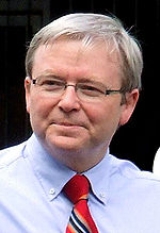
, leader of the Cabinet
and Head of
Her Majesty's Australian Government
, holding office on commission from the Governor-General of Australia
. The office of Prime Minister is, in practice, the most powerful political office in Australia. Despite being at the apex of executive government in the country, the office is not mentioned in the Constitution of Australia
specifically (although the Constitution does refer to "The Queen's Ministers of State for the Commonwealth [of Australia]" in general) and exists through an unwritten constitutional convention
.
Barring exceptional circumstances, the prime minister is always the leader of the political party
or coalition with majority support in the House of Representatives
.
1901 The British colonies of New South Wales, Queensland, Victoria, South Australia, Tasmania and Western Australia federate as the Commonwealth of Australia; Edmund Barton is appointed the first Prime Minister.
1905 Alfred Deakin becomes Prime Minister of Australia for the second time.
1909 Alfred Deakin becomes Prime Minister of Australia for the third time.
1914 Andrew Fisher becomes Prime Minister of Australia for the third time.
1916 Prime Minister of Australia Billy Hughes is expelled from the Labor Party over his support for conscription.
1964 Prime Minister of Australia Robert Menzies opens the artificial Lake Burley Griffin in the middle of the capital Canberra.
1967 Prime Minister of Australia Harold Holt disappears while swimming near Portsea, Victoria and was presumed drowned.
1967 Prime Minister of Australia Harold Holt is officially presumed dead.
1975 Australian constitutional crisis of 1975: Australian Governor-General Sir John Kerr dismisses the government of Gough Whitlam, appoints Malcolm Fraser as caretaker Prime Minister and announces a general election to be held in early December.
2007 Australians elect the centre-left Australian Labor Party at a federal election; the outgoing prime minister, John Howard, becomes the first since 1929 to lose his own seat.

